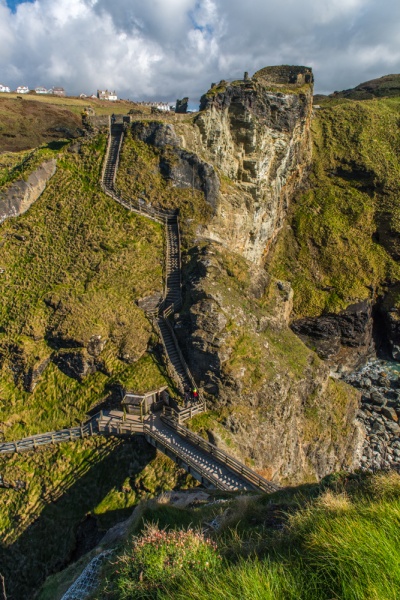
The small Cornish village of Tintagel is one of the most popular destinations for tourists in south-west England. Most are drawn to the romantic ruins of Tintagel Castle with its links to the tales of King Arthur and his Knights of the Round Table.
One version of the stories says that Tintagel Castle was the place where Arthur was conceived after Uther Pendragon disguised himself as the King of Cornwall and seduced the unwitting queen while the real king was absent. Other versions suggest that the castle was Arthur's Camelot, where he ruled Cornwall with the aide of his trusty knights.
Neither tale stands up to scrutiny, but that doesn't stop the hordes of tourist who descend on this pretty village each year. The castle that clings to the clifftops and headlands is medieval, begun in the Norman period, much later than the setting for the real King Arthur's reign. Yet perhaps there is something to the legends, for there are obvious signs of much earlier occupation of the castle site.

Tintagel Castle
Visiting the castle takes a fair bit of effort. You have to walk down a very steep approach track from the village, then up very steep steps to reach the castle. A wooden footbridge leads visitors to Tintagel Island, where you will find the ruins of a Celtic monastery atop the windblown headland. The scenery is utterly stunning, and it is well worth taking your time to explore the site and soak in the amazing coastal views.
A pair of tunnels run beneath the island. The larger of these tunnels is known as Merlin's Cave, and it is said that the wizard's voice can be heard in the cave. Alfred, Lord Tennyson, incorporated the cave in his famous poem The Idylls of the King, where he described Merlin standing at the cave mouth, raising the infant Arthur aloft in his arms.
On the summit of Tintagel Island is a burial mound known as Condolden Barrow, rather romantically believed to be the burial place of Queen Isolde, but much more likely to be the last resting place of Cador, a 6th-century king of Cornwall. Cador is variously said to have acted as the sword-bearer at King Arthur's coronation, led the British army to victory against the West Saxons at the Battle of Mount Badon, raised Queen Guinevere as a child, and been one of Arthur's trusted knights.
Legends of King Arthur aside - and it can be hard to explore Tintagel without becoming immersed in Arthurian legend - there is plenty of historic interest in the village.

Tintagel Old Post Office
On Fore Street is the Old Post Office, a beautiful 14th-century building under a slate roof. As the name suggests, this was once the village post office, but more importantly, it is a wonderful example of a medieval manor house, begun around 1380 as a longhouse, a simple rectangular building with one end used as a stable for animals.
It was remodelled in the 16th century when small bedchambers were added to each end, leaving the central hall open to the rafters. Behind the Old Post Office is a traditional cottage garden. The building is now under the care of the National Trust, and is well worth a visit.
If you go out the front entrance of the Old Post Office and turn left down Fore Street, you will come to a turning onto Vicarage Hill. Follow the road as it plunges down the steep hill, then rises up Church ill to reach the ancient parish church of St Materiana.

St Materiana's Church
The church we see today dates to the 12th century, though it incorporates pre-Norman stonework and probably stands on the site of a 6th-century oratory. In the churchyard is a Bronze Age standing stone, and preserved in the south transept is a 4th-century Roman milestone. Look for the crudely carved Norman font, decorated with figures of serpents and grotesque faces.
From the chancel and narrow doorway leads down into a small chapel, said to be the site of a medieval anchorite's cell. In the chapel is an ancient font bowl thought to have been brought from the chapel of Tintagel Castle.
King Arthur's Great Halls
One of the more unusual attractions in Tintagel is King Arthurs Great Halls on Fore Street. From the exterior the Great Halls looks like a typical grey granite Cornish house, but inside, well, prepare to enter the realm of King Arthur and his knights. The Great Halls were erected in 1933 by Frederick Thomas Glasscock as a home for the Order of the Fellowship of the Knights of the Round Table, a group aiming to promote Christian values and ideals of behaviour.
At the heart of the building is the Hall of Chivalry, a long rectangular chamber illuminated by a series of stunning Arts and Crafts stained glass windows by Veronica Whall. The Halls are full of Arthurian symbology and stories of King Arthur, but it is the superb stained glass that most people come to see, and with good reason.
If you take the South West Coast Path from the Glebe Cliff car park and follow the trail north along the cliffs towards Boscastle you will come to Lady's Window, a peculiar rock formation like a window cut through an outcrop of solid rock.

A few miles south of Tintagel, on the road to Boscastle, is St Piran's Chapel, a small medieval building possibly built by monks of St Pirans monastery at Perranzabuloe. Near the chapel is an ancient holy well, and on the lane below the chapel is a Roman milestone dating to the 3rd century. From St Piran's Chapel a trail leads beside the River Trevillet to St Nectan's Glen and Hermitage, the site of a 6th-century hermit cell established by St Nectan, and a destination for pilgrims for 1500 years.
Visiting
Tintagel is well served by local transport, and is directly on the South West Coast Path if your 'local transport' is your own two legs. There is a large pay and display car park on the B3263 (Bossiney Road) directly beside the tourist information centre. There is also a free car park beside St Materiana's church at the top of Church Hill. I've visited Tintagel numerous times, and can't wait to return.
About Tintagel
Address: B3263,
Tintagel,
Cornwall,
England
Attraction Type: Village
Location: On the B3263, five miles north-west of Camelford
Website: Tintagel
Location map
OS: SX056886
Photo Credit: David Ross and Britain Express
POPULAR POSTS
HERITAGE
 We've 'tagged' this attraction information to help you find related historic attractions and learn more about major time periods mentioned.
We've 'tagged' this attraction information to help you find related historic attractions and learn more about major time periods mentioned.
Find other attractions tagged with:
NEARBY HISTORIC ATTRACTIONS
Heritage Rated from 1- 5 (low to exceptional) on historic interest
King Arthurs Great Halls - 0.1 miles (Historic Building) ![]()
Tintagel Old Post Office - 0.1 miles (Historic Building) ![]()
Tintagel Castle - 0.4 miles (Castle) ![]()
Tintagel, St Materiana's Church - 0.4 miles (Historic Church) ![]()
Rocky Valley Labyrinths - 1.1 miles (Prehistoric Site) ![]()
Trethevy, St Piran's Chapel and Holy Well - 1.3 miles (Historic Church) ![]()
St Nectan's Glen Waterfall & Hermitage - 1.5 miles (Prehistoric Site) ![]()
Trevalga, St Petroc's Church - 1.7 miles (Historic Church) ![]()














